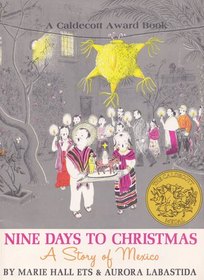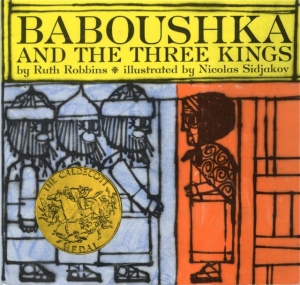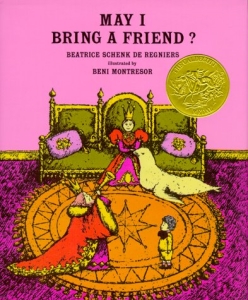2018 School Spending Survey Report
Horn Book reviews of Caldecott Medal winners, 1960-1969
1960
MARIE HALL ETS and AURORA LABASTIDA
Nine Days to Christmas (Viking)
Illustrated by Marie Hall Ets
The creator of Play with Me and her co-author, who has worked with children at the Benjamin Franklin Library in Mexico City, have together produced a charming Christmas picture book.
 MARIE HALL ETS and AURORA LABASTIDA
MARIE HALL ETS and AURORA LABASTIDA Nine Days to Christmas (Viking)
Illustrated by Marie Hall Ets
The creator of Play with Me and her co-author, who has worked with children at the Benjamin Franklin Library in Mexico City, have together produced a charming Christmas picture book. The significance of the Mexican posada and piñata is demonstrated through the feelings of Ceci who now, at five, is allowed to stay up for one of the special holiday parties, in the series of nine held nightly before Christmas. Ceci goes to the market place to select her piñata; her cousin Manuel leads the singing procession of the posada; the excited scrambling for the contents of the piñata climaxes the evening — all pictured with truth to small details of scene and costume, in brilliant touches of Mexican colors on a soft gray background for striking and original effects.
reviewed in the December 1959 issue of The Horn Book Magazine
1961
 RUTH ROBBINS
RUTH ROBBINS Baboushka and the Three Kings (Parnassus)
Illustrated by Nicholas Sidjakov
Mystery and dignity are in the retelling of the old Russian folk tale of Baboushka's meeting with the Three Kings in their search for the Babe of Bethlehem, and her own search for the Child. At the end of the book is the story in verse set to original music. Extraordinary modern drawings, some in rich colors, and a handsome type face which has not been popular for many years combine to make a beautiful picture book.
reviewed in the December 1960 issue of The Horn Book Magazine
1962
 MARCIA BROWN, Author-Illustrator
MARCIA BROWN, Author-Illustrator Once a Mouse (Scribner)
It is hard to find fresh words of praise for the versatility of this artist, but one can say that her woodcuts for this fable from the Indian Hitopadesa are fresh in effect and that the total composition of this book is quite different from that of any other of her many picture books. The pictures are printed in a bold combination of dark gold, raspberry red, and the olive green used for the text. There is lively action in spreads showing how a hermit “thinking about big and little” suddenly saves a mouse from a crow and then from larger enemies by turning the little creature into the forms of bigger and bigger animals — until as a royal tiger it has to be humbled.
reviewed in the February 1962 issue of The Horn Book Magazine
1963
 EZRA JACK KEATS, Author-Illustrator
EZRA JACK KEATS, Author-Illustrator The Snowy Day (Viking)
In this mood book, never static but sparkling with atmosphere in lovely water-color pictures, a small boy experiences the joys of a snowy day. The brief, vividly expressed text points out his new awareness of the sight and texture of snow (the crunch, crunch of his feet making tracks), the sound (the plop of snow smacked off a tree with a stick), and the fun of playing with snow — then his thinking and thinking about the outdoor adventures later in warm bathtub and bed, while more snowflakes fall. Perfect for a snowy day's preschool story hour.
reviewed in the February 1963 issue of The Horn Book Magazine
1964
 MAURICE SENDAK, Author-Illustrator
MAURICE SENDAK, Author-Illustrator Where the Wild Things Are (Harper)
This vibrant picture book in luminous, understated full color has proved utterly engrossing to children with whom it has been shared. As well as the pictorial grotesqueries — both deliciously monstrous and humorous — they love the idea of a small boy, punished by isolation for his naughty “wildness,” dreaming up hideous wild things to whom he sails away in a private boat, taming them and then becoming their king. The situation is entirely composed and childlike — the boy treats them to going to bed without their supper. Then, of course, he sails back home to find his supper, still hot, waiting for him. A sincere, perceptive contribution which bears repeated examination.
reviewed in the April 1964 issue of The Horn Book Magazine
1965
 BEATRICE SCHENK DE REGNIERS
BEATRICE SCHENK DE REGNIERS May I Bring a Friend? (Atheneum)
Illustrated by Beni Montresor
Each time he receives an invitation to a repast with the king and queen, the boy asks to bring a friend, and hospitality is extended. Consequently, a series of exotic animals are welcomed and entertained in the royal “house.” The king and the queen are models of regal composure. When the boy has thoroughly tried their friendship and has found it thoroughly true, be returns their hospitality by giving a most unusual party for them. The poetic text can be read by seven-year-olds, but many of the subtleties will escape all save the worldly-wise. Rich color and profuse embellishment adorn an opulent setting. Absurdities and contrasts are so imaginatively combined in a hilarious comedy of manners that the merriment can be enjoyed on several levels.
reviewed in the October 1964 issue of The Horn Book Magazine
1966
 SORCHE NIC LEODHAS
SORCHE NIC LEODHAS Always Room for One More (Holt)
Illustrated by Nonny Hogrogian
A rendering into modern English of the verses of a traditional Scottish folk song. In “a wee house in the heather” lived Lachie MacLachlan with his good wife “and his bairns to the number of ten.” So great were his heart and his hospitality that on stormy nights Lachie would invite every passing traveler to share his tiny hearth. Then the merry crowd would sing and pipe and dance until one fatal evening “the rafters they clappit like thunder” and the walls came tumbling down. A glossary explains the meanings of a few Scottish words in the text; the basic tune is indicated. Pen-and-ink drawings — hatched and cross-hatched to produce a fascinating texture — are color washed with heathery tones of purple and green.
reviewed in the December 1965 issue of The Horn Book Magazine
1967
 EVALINE NESS, Author-Illustrator
EVALINE NESS, Author-Illustrator Sam, Bangs & Moonshine (Holt)
Motherless Samantha (called Sam), living on an island, had the lonely child's predilection for daydreams: her mother was not dead — but a mermaid, and Sam had at home not only Bangs, her wise old cat (who could talk), but a fierce lion and a baby kangaroo! Her practical fisherman-father was worried, “ ...for a change, talk REAL not MOONSHINE. MOONSHINE spells trouble.” Not until her wildly exaggerated “Moonshine” talk sent her only friend with her beloved cat to near destruction did Sam realize the grown-up difference between true imagination and uncontrolled flights of fancy. For children, the understated story may be thought-provoking and slightly enigmatic. Never has the artist made more striking pictures, nor has she ever showed more beautifully her sense of pattern and design than in these subdued color-washed drawings seen through a sea mist or a “grey ribbed curtain of rain.” An interesting choice for reading aloud.
reviewed in the December 1966 issue of The Horn Book Magazine
1968
 BARBARA EMBERLEY, Adapter
BARBARA EMBERLEY, Adapter Drummer Hoff (Prentice)
Illustrated by Ed Emberley
Stylized woodcuts in brilliant hues develop this martial folk rhyme into a sprightly book which the young child will enjoy again and again. The pictures are to be re-examined for their entertaining details (birds, ladybugs, and flowers appear and reappear), and the lines of the brief text are to be chanted for their alliterative nonsense. The whole story of the cannon-firing is told in cumulated couplets in seven steps, including “General Border/ gave the order…/ Sergeant Chowder/ brought the powder…/ but Drummer Hoff fired it off.” This descending order is, of course, as it should be, the least important in the ranks directly causing the violent explosion pictured in the final double-spread. An interesting contrast to the artist’s more quietly charming London Bridge Is Falling Down (Little).
reviewed in the February 1968 issue of The Horn Book Magazine
1969
 ARTHUR RANSOME, Reteller
ARTHUR RANSOME, Reteller The Fool of the World and the Flying Ship: A Russian Tale (Farrar)
Illustrated by Uri Shulevitz
Choosing a story from Old Peters Russian Tales, the artist has faithfully depicted the action in which the scorned younger son of peasants — the Fool of the World — is rewarded for his kindness to “an ancient old man” and goes on to win the Czar’s daughter. In line drawings with watercolor wash predominantly yellow and green, the artist captures the gauche personalities of the peasant imagination and portrays the flat and ample Russian landscape. The flying ship is a ship with sails, enabling the illustrator to secure movement and variety by alternating aerial with earth-bound scenes. The final two-page spread glows with color as the artist permits himself at last a greater use of blue and red. If the transformation of the Fool of the World suggests the final scene in a Russian ballet based on folklore, the illustrator has not been unfaithful to the story but has simply added to it a justifiable clement of visual splendor.
reviewed in the February 1969 issue of The Horn Book Magazine
These reviews of 1960s Caldecott Medal–winning titles are part of our Caldecott at 75 celebration. Click here for more archival Horn Book material on Drummer Hoff.
RECOMMENDED
ALREADY A SUBSCRIBER? LOG IN
We are currently offering this content for free. Sign up now to activate your personal profile, where you can save articles for future viewing.






Add Comment :-
Be the first reader to comment.
Comment Policy:
Comment should not be empty !!!